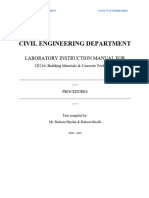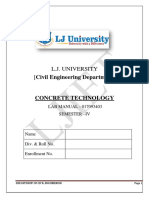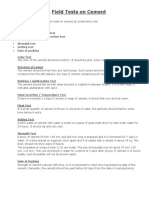Fineness Test (Concrete)
Fineness Test (Concrete)
Uploaded by
Dira AzmanCopyright:
Available Formats
Fineness Test (Concrete)
Fineness Test (Concrete)
Uploaded by
Dira AzmanOriginal Title
Copyright
Available Formats
Share this document
Did you find this document useful?
Is this content inappropriate?
Copyright:
Available Formats
Fineness Test (Concrete)
Fineness Test (Concrete)
Uploaded by
Dira AzmanCopyright:
Available Formats
CONTENT
NO 1 2 3 4 5 6 7 8 9 10
TITLE THEORY APPARATUS MATERIAL PROCEDURES RESULT DISCUSSION CONCLUSION QUESTIONS APPENDIX REFERENCE
PAGE 1 1 2 2 3 4 5 6 7 8
0|Page
EXPERIMENT TITLE 1 OBJECTIVE
: : :
1 FINENESS TEST To determine the fineness of cement by dry sieving.
THEORY So we need to determine the fineness of cement by dry sieving as per IS: 4031 (Part 1) 1996. The principle of this is that we determine the proportion of cement whose grain size is large the specified mesh size. The fineness of cement influences the drying shrinkage of concrete. When the water content is increased because of fineness, the drying shrinkage is increased. However, if excessive bleeding due to coarseness of the cement takes place, a reduction in the drying shrinkage occurs.
APPARATUS 1. 2. 3. 4. 5. 90 m IS Sieve, Balance capable of weighing 10g to the nearest 10mg A nylon or pure bristle brush, preferably with 25 to 40mm. Bristle, for cleaning the sieve. Sieve shown in picture below is not the actual 90m sieve.
1|Page
MATERIAL
Ordinary Portland cement
PROCEDURE
Procedure to determine fineness of cement
i.
10g of cement to the nearest 0.01g was weighed approximately and placed it on the sieve.
ii.
The sieve agitated by swirling, planetary and linear movements, until no more fine material passes through it.
iii. iv.
The timer was started when the sieve agitated was started. The residue Weighed and expressed its mass as a percentage R1, of the quantity first placed on the sieve to the nearest 0.01 percent.
v.
Gently brushed all the fine material off the base of the sieve.
vi.
Repeat the whole procedure using a fresh 10g sample to obtained R2 and R3. Then calculate R as the mean of R1 and R2 as a percentage average, expressed to the nearest 0.1 percent. When the results differ by more than 1 percent absolute, carry out a third sieving and calculate the mean of the three values.
2|Page
RESULT
R1 Weight of sieve Weight of sieve + sample Weight of sieve + sample retained Sample retained on sieve Percentage weight of residue 260.2 g 270.2 g 269.6 g 0.6 6%
R2 260.3 g 270.3 g 269.6 g 0.7 7%
R3 260.2 g 270.2 g 260.6 g 0.4 4%
% Weight of Residue , R1 =
Weight of Sample Retained on the Sieve Total Weight of the Sample
3|Page
DISCUSSION For concrete containing no entrained air, there is a slight decrease in the static modulus of elasticity at 28 days' age as the fineness is increased. The modulus of elasticity of concrete determined by sonic methods decreases as the fineness of the cement increases. The fineness of cement influences the drying shrinkage of concrete. When the water content is increased because of fineness, the drying shrinkage is increased. However, if excessive bleeding due to coarseness of the cement takes place, a reduction in the drying shrinkage occurs. The resistance of air-entrained concrete to deterioration caused by freezing and thawing decreases with an increase in cement fineness. The same trend is noted with non air-entrained concrete, but to a lesser degree.
Limits: The percentage residue should not exceed 10%.
Precautions: Sieving shall be done holding the sieve in both hands and gentle wrist motion, this will involve no danger of spilling the cement, which shall be kept well spread out on the screen. More or less continuous rotation of the sieve shall be carried out throughout sieving. Washers, shots and slugs shall not be used on the sieve. The underside of the sieve shall be lightly brushed with a 25 or 40mm bristle brush after every five minutes of sieving. Mechanical sieving devices may be used, but the cement shall not be rejected if it meets the fineness requirement when tested by the hand method.
4|Page
CONCLUSION The air-void system in air-entrained concrete or concrete containing no entrained air is not significantly affected by variations in the fineness of cement. The 28-day compressive strength of concrete, with or without entrained air, increases with an increase in cement fineness. The difference in compressive strength due to difference in fineness of cement is considerably less at 1 year's age. Both air-entrained and non air-entrained concrete containing 100 percent reactive aggregate are detrimentally affected by increased expansion at all ages by increases in the fineness of high-alkali cement. Very coarse cement under some conditions can cause a serious bleeding problem on some construction projects. When a cement is used that meets the present Federal specifications, it is doubtful that a field construction problem could be greatly influenced by changing the cement fineness.
5|Page
QUESTIONS
1. Why do you need to do this for cement?
The tests should be performed to determine the characteristics of cement and its compatibility with other materials in the concrete mix design.
2. What the implication of fineness cement to the concrete mixture?
Here are the conclusions offered in a paper by E. C. Higginson on "The Effect of Cement Fineness on Concrete":
1. Increasing the fineness of cement reduces the amount of bleeding in concrete. This is more pronounced for concrete containing no entrained air.
2.
Increasing the fineness of cement from 2700 to about 4000 cm2/g reduces the water requirement of concrete. Increasing the fineness of cement beyond an optimum limit increases the water requirement of concrete.
3. The workability of non air-entrained concrete is increased by increasing the cement fineness. In air-entrained concrete the effect of fineness of cement on workability is very much less pronounced.
6|Page
APPENDIX
bristle brush
Portland cement
90 m IS Sieve
Balance
7|Page
REFERENCE
1. http://www.concreteconstruction.net/concrete-articles/cement-fineness.aspx 2. http://en.wikipedia.org/wiki/Cement
8|Page
You might also like
- ESTIMATE by Max FajardoDocument169 pagesESTIMATE by Max FajardoJay-Jay Japs88% (180)
- Shear Box TestDocument24 pagesShear Box TestDira Azman88% (8)
- Jocab Builders: Company ProfileDocument23 pagesJocab Builders: Company ProfileTullao Mark CarloNo ratings yet
- School of Building and Civil Engineering: Cest-SbceDocument11 pagesSchool of Building and Civil Engineering: Cest-SbceVishwaleen RamNo ratings yet
- Material Reconciliation SheetDocument1 pageMaterial Reconciliation SheetJustin RanjitNo ratings yet
- MVSE-106 Lab-II CONCRETE LABDocument55 pagesMVSE-106 Lab-II CONCRETE LABABHISHEK PANDYANo ratings yet
- Experiment No. 1 Fineness of Cement by Hand SievingDocument22 pagesExperiment No. 1 Fineness of Cement by Hand SievingUmed Abd-alsatarNo ratings yet
- Material Testing Lab Manual-Expt-1to 14Document50 pagesMaterial Testing Lab Manual-Expt-1to 14rajat debnathNo ratings yet
- Experiment-No 6Document4 pagesExperiment-No 6Rose Anne Yalung YabutNo ratings yet
- Fineness and Consistency of CementDocument21 pagesFineness and Consistency of CementIan Rovic CruzNo ratings yet
- Theory PDFDocument73 pagesTheory PDFZhir nawzadNo ratings yet
- Fineness of Cement 1Document7 pagesFineness of Cement 1Teslim AyomideNo ratings yet
- WINSEM2019-20 CLE2007 ELA VL2019205006005 Reference Material I 03-Dec-2019 ACT Laboratory ManualDocument51 pagesWINSEM2019-20 CLE2007 ELA VL2019205006005 Reference Material I 03-Dec-2019 ACT Laboratory ManualAaditya AgrahariNo ratings yet
- Report 1 Testing On Cement: Engineering MaterialsDocument9 pagesReport 1 Testing On Cement: Engineering MaterialsEman SalahNo ratings yet
- Concrete Laboratory ManualDocument50 pagesConcrete Laboratory ManualSamareshNo ratings yet
- Fineness Test On CementDocument13 pagesFineness Test On CementTvsp Sekhar50% (2)
- Testingofcements 150228004637 Conversion Gate02Document23 pagesTestingofcements 150228004637 Conversion Gate02jaishpratapsinghNo ratings yet
- Presentation (14)Document21 pagesPresentation (14)MadhanNo ratings yet
- Lju CT Lab Manual Dku FinalDocument52 pagesLju CT Lab Manual Dku FinalAryan RathodNo ratings yet
- Muddasar Ahmed (Cms Id 6139) Material Engineering Lab PracticalsDocument15 pagesMuddasar Ahmed (Cms Id 6139) Material Engineering Lab PracticalsAafaq Ur RehmanNo ratings yet
- T Proc Notices Notices 040 K Notice Doc 35762 449071606Document5 pagesT Proc Notices Notices 040 K Notice Doc 35762 449071606jaafar abdullahNo ratings yet
- Lecture #2&3 Fineness and Normal Consistency of Portland CementDocument24 pagesLecture #2&3 Fineness and Normal Consistency of Portland CementRome Lauren JavierNo ratings yet
- CE F230 Lab ManualDocument51 pagesCE F230 Lab ManualSK ABDUL KAIUMNo ratings yet
- Testing Procedures Adopted For Cement and SteelDocument6 pagesTesting Procedures Adopted For Cement and Steelp.v.n. lakshmanNo ratings yet
- Fineness of Portland CementDocument4 pagesFineness of Portland CementJose Marie BorbeNo ratings yet
- Concrete Technology Lab-Manual - English - FinalDocument49 pagesConcrete Technology Lab-Manual - English - Finalanandswami2562006No ratings yet
- Test On Cement PDFDocument6 pagesTest On Cement PDFIrfan NazirNo ratings yet
- 5 Materials of Cement ConcreteDocument27 pages5 Materials of Cement ConcretesetumehtaNo ratings yet
- Sci1103 Unit 4notesDocument84 pagesSci1103 Unit 4notesSalin RajNo ratings yet
- Document Cement Ex 1Document7 pagesDocument Cement Ex 1Ferhaj KhalidNo ratings yet
- 04a Physical PropertiesDocument13 pages04a Physical PropertiesGanesh.RajanNo ratings yet
- Cemetn TestingDocument20 pagesCemetn TestingKrishnan SubramaniamNo ratings yet
- Concrete Technology (Lab Manual)Document23 pagesConcrete Technology (Lab Manual)VipulShukla100% (3)
- General Notes For Civil Engineering Standard Data For Civil EngineersDocument8 pagesGeneral Notes For Civil Engineering Standard Data For Civil EngineersMahesh Savandappa100% (2)
- CementsDocument11 pagesCementsmd nasirNo ratings yet
- Conferences Effect of Grinding Aids On CementDocument16 pagesConferences Effect of Grinding Aids On CementMarey MorsyNo ratings yet
- Consistency of Standard Cement PasteDocument53 pagesConsistency of Standard Cement PasteLakshay SinghalNo ratings yet
- Compaction Factor ExperimentDocument23 pagesCompaction Factor ExperimentYI HEN ONGNo ratings yet
- Cycle 2 Som LabDocument10 pagesCycle 2 Som LabAnonymous SEDun6PWNo ratings yet
- PUSA Concrete Lab ManualDocument51 pagesPUSA Concrete Lab Manualaryanguptabhadara6No ratings yet
- Testing of AggregatesDocument5 pagesTesting of AggregatesKumari SandhyaNo ratings yet
- BC 2Document4 pagesBC 2Hib BundNo ratings yet
- Physical Test On OPCDocument16 pagesPhysical Test On OPCসন্দীপ চন্দ্রNo ratings yet
- CMT Laboratory ExperimentsDocument4 pagesCMT Laboratory ExperimentsErvi Soriano FabrosNo ratings yet
- Concrete Mix DesignDocument14 pagesConcrete Mix Designchaos_atulNo ratings yet
- Drying Shrinkage of ConcreteDocument6 pagesDrying Shrinkage of Concretecrownguard100% (1)
- Various Lab Test On CementDocument4 pagesVarious Lab Test On Cementhncc ghazniNo ratings yet
- Cemetn TestingDocument20 pagesCemetn TestingKrishnan SubramaniamNo ratings yet
- Cement Concrete Hollow Block and ConcreteDocument99 pagesCement Concrete Hollow Block and ConcreteEchanez, Gem Krian0% (1)
- CT Lab ManualDocument38 pagesCT Lab ManualAadi KmrNo ratings yet
- Control of Shrinkage and Curling in SlabDocument5 pagesControl of Shrinkage and Curling in SlabNik FavrettoNo ratings yet
- Project Wearing Surface TechnoloigyDocument20 pagesProject Wearing Surface TechnoloigySajeer SayedaliNo ratings yet
- Lab ManualDocument23 pagesLab ManualSuraj AgrawalNo ratings yet
- CONCRETE MIX DESIGN LectureDocument32 pagesCONCRETE MIX DESIGN LectureMichael Murillo BaraquioNo ratings yet
- Determination of Fineness of Hydraulic Cement by The No. 200 SieveDocument3 pagesDetermination of Fineness of Hydraulic Cement by The No. 200 SieveCamille Andrea SequitinNo ratings yet
- Sewage Disposal Works: Their Design and ConstructionFrom EverandSewage Disposal Works: Their Design and ConstructionNo ratings yet
- The Rudiments Of Practical Bricklaying - In Six Sections: General Principles Of Bricklaying, Arch Drawing, Cutting, And Setting, Different Kinds Of Pointing, Paving, Tiling, Materials, Slating, And Plastering, Practical Geometry MensurationFrom EverandThe Rudiments Of Practical Bricklaying - In Six Sections: General Principles Of Bricklaying, Arch Drawing, Cutting, And Setting, Different Kinds Of Pointing, Paving, Tiling, Materials, Slating, And Plastering, Practical Geometry MensurationRating: 5 out of 5 stars5/5 (1)
- Chimneys & Fireplaces: They Contribute to the Health Comfort and Happiness of the Farm Family - How to Build ThemFrom EverandChimneys & Fireplaces: They Contribute to the Health Comfort and Happiness of the Farm Family - How to Build ThemNo ratings yet
- Ceramic Materials for Energy Applications VIFrom EverandCeramic Materials for Energy Applications VIHua-Tay LinNo ratings yet
- Advanced Processing and Manufacturing Technologies for Nanostructured and Multifunctional Materials IIFrom EverandAdvanced Processing and Manufacturing Technologies for Nanostructured and Multifunctional Materials IITatsuki OhjiNo ratings yet
- Final Examination SEMESTER I, SESSION 2015/2016: Instruction To CandidatesDocument10 pagesFinal Examination SEMESTER I, SESSION 2015/2016: Instruction To CandidatesDira AzmanNo ratings yet
- Data Analysis Traffic VolumeDocument2 pagesData Analysis Traffic VolumeDira AzmanNo ratings yet
- Rebound HammerDocument6 pagesRebound HammerDira AzmanNo ratings yet
- Job Application LetterDocument1 pageJob Application LetterDira AzmanNo ratings yet
- Move The Drawing: Select The Drawing As in Picture, Then Press M' and Space Bar or EnterDocument4 pagesMove The Drawing: Select The Drawing As in Picture, Then Press M' and Space Bar or EnterDira AzmanNo ratings yet
- Mini Project Communicative EnglishDocument1 pageMini Project Communicative EnglishDira AzmanNo ratings yet
- Penetration Test DiscussionDocument2 pagesPenetration Test DiscussionDira Azman67% (6)
- Difference Between Floor Tiles and Wall TilesDocument2 pagesDifference Between Floor Tiles and Wall TilesDira AzmanNo ratings yet
- Report Silt Test For SandDocument10 pagesReport Silt Test For SandDira Azman80% (5)
- រឿង កំណប់ឪពុកDocument22 pagesរឿង កំណប់ឪពុកសាលាបឋមសិក្សា តាព្រហ្មក្ដុរ0% (1)
- Lecture 1-1Document14 pagesLecture 1-1imaniNo ratings yet
- 02 Tinalmud Nuevo - Tinalmud ViejoDocument13 pages02 Tinalmud Nuevo - Tinalmud ViejoWynmar Kevyn MarquezNo ratings yet
- City Government of Cotabato: Fourth Floor PlanDocument1 pageCity Government of Cotabato: Fourth Floor PlanAIMAN ABBASNo ratings yet
- Pump HouseDocument42 pagesPump Housedesire designNo ratings yet
- FireDrill and Inspection Guide GujaratDocument35 pagesFireDrill and Inspection Guide GujaratMageshNo ratings yet
- QT1-EVNPMB2-0-NCR-Z-013 Water Treament System of AccommondationDocument3 pagesQT1-EVNPMB2-0-NCR-Z-013 Water Treament System of AccommondationDoan Ngoc DucNo ratings yet
- Extec C12 PDF - 0 - 0Document21 pagesExtec C12 PDF - 0 - 0gugi100% (1)
- 114 Layout Secrets For Your Framing Square PDFDocument2 pages114 Layout Secrets For Your Framing Square PDFHomerSimsonnakis100% (1)
- Thesis Fulltext PDFDocument155 pagesThesis Fulltext PDFJaycee PagadorNo ratings yet
- A Study On The Concrete Mix Design With Fly Ash For Multistoried BuildingsDocument8 pagesA Study On The Concrete Mix Design With Fly Ash For Multistoried BuildingsAlfadinAzzahrawaaniElNauvalNo ratings yet
- Honey Combed ConcreteDocument2 pagesHoney Combed ConcreteManish WaniNo ratings yet
- Material Description Weight / Ft. Weight / Mtr. Thickness AngleDocument4 pagesMaterial Description Weight / Ft. Weight / Mtr. Thickness Anglerajeshh294No ratings yet
- Comparative Study of Concrete Mix Design by Adding Various Types of AdmixturesDocument6 pagesComparative Study of Concrete Mix Design by Adding Various Types of AdmixturesSagarNo ratings yet
- E20 SheetDocument1 pageE20 SheetAbdul NoufalNo ratings yet
- 1 - WSDDocument27 pages1 - WSDXzk MallaboNo ratings yet
- Lean Construction Project Management. PrihadiDocument23 pagesLean Construction Project Management. PrihadiAyahe BiyuNo ratings yet
- Worksheet 1 - Week 5 Cable Calculations (1)Document5 pagesWorksheet 1 - Week 5 Cable Calculations (1)xuan.zhang920No ratings yet
- BS 8500 For Building Structures: Concrete Design InformationDocument8 pagesBS 8500 For Building Structures: Concrete Design Informationroyal_eagle04No ratings yet
- Flowchart Design Pile FoundationDocument1 pageFlowchart Design Pile FoundationMengly SengNo ratings yet
- Sprinkler Head - Victaulic Sidewall Quick Response V2710Document6 pagesSprinkler Head - Victaulic Sidewall Quick Response V2710Shayan IrevaniNo ratings yet
- Mouldiness ManifestoDocument6 pagesMouldiness ManifestoYiğit DemirtaşNo ratings yet
- Underground Cables PDFDocument4 pagesUnderground Cables PDFSukhpal SinghNo ratings yet
- CV - Muhammad Adam PDFDocument7 pagesCV - Muhammad Adam PDFErwin StiadiNo ratings yet
- EIFS-Brochure A4Document32 pagesEIFS-Brochure A4Vaittianathan MahavapillaiNo ratings yet
- Review of Construction Site Safety in BangladeshDocument76 pagesReview of Construction Site Safety in BangladeshSadia PressNo ratings yet
- Ficha Tecnica - Lana Mineral ThermafiberDocument2 pagesFicha Tecnica - Lana Mineral ThermafiberJeshua Diego BarrientosNo ratings yet



































































































